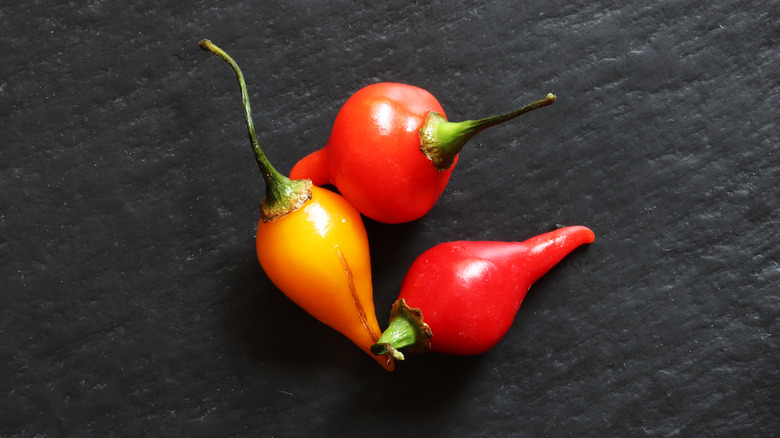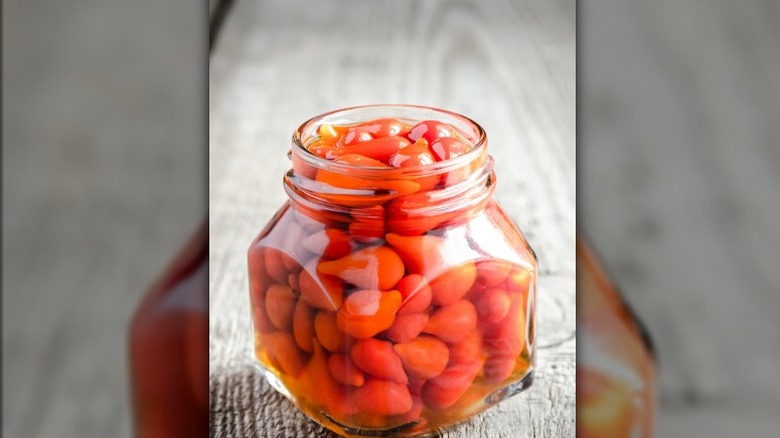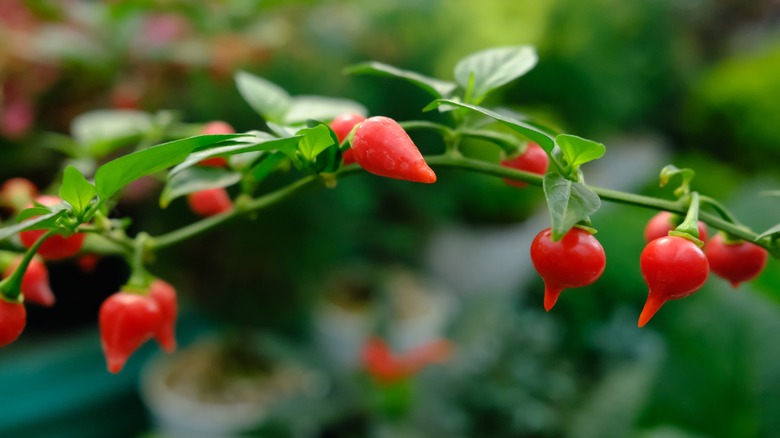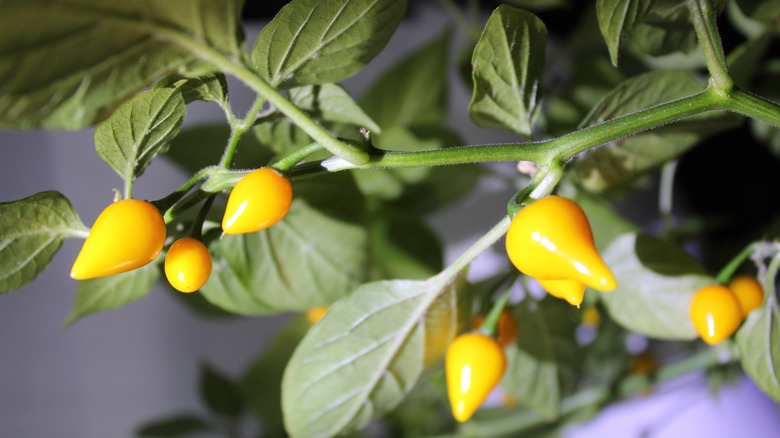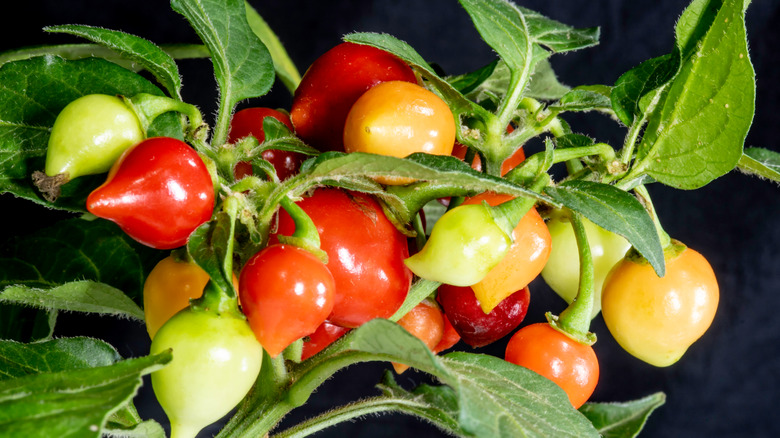What Are Biquinho Peppers And How Spicy Are They?
Consider the plight of a grocery-shopping time traveler plucked from a 1970s produce department just as they reach for a standard green bell pepper and then plunked in front of the pepper display in a 21st-century supermarket. The varieties of peppers — shapes, sizes, colors, and heat scales — we've come to expect at even the most basic grocery store would be overwhelming. Improved growing techniques and a global shipping network make fruits and vegetables native to locations on the other side of the globe easily accessible, presenting us with options a mid-20th-century shopper would never imagine. Case in point, the adorable biquinho pepper.
Native to Minas Gerais, a landlocked state in southeastern Brazil, biquinho peppers (Capsicum chinense) are a popular snack in Brazil's botecos, or neighborhood bars, where they're pickled in a blend of vinegar, garlic, herbs, and cachaça, a rum-like Brazilian liquor, and served with small plates of sausage or fish. They also add a pop of color to the table. The two varieties of biquinho peppers — red and yellow — are so similar, they can readily be swapped or combined. We mentioned they are adorable. Even the name, biquinho, is cute. It's a nod to the pointy-tipped, droplet-shaped pepper's resemblance to a bird's beak. The Portuguese word biquinho translates to "little beak" in English.
Until recently, biquinhos in the U.S. were most often found in ornamental gardens and prized for the bright pop of color they bring to landscape settings, but they are beginning to make their way into grocery stores.
What are biquinho peppers?
Usually about an inch long from top to tip, biquinho peppers grow from a thin green stem, developing a bulbous center that tapers and curves toward a pointy, beaklike end. As the peppers mature, their color changes from pale green to glossy red or yellow. In terms of taste and texture, the outer skin gives way to a pulpy shell surrounding a pocket of thin, nearly flavorless seeds similar to those found in other pepper varieties. The taste experience of a garden-fresh biquinho pepper begins with a crunch through the skin and shell that initially releases a slightly sour, maybe fruity, taste before giving way to a touch of heat. And, at less than 50 calories per cup, they are an attractive option for anyone seeking a fresh and crunchy, sweet-hot snack.
When you're talking about fresh peppers, the first question is usually, "Are they hot?" So we'd be remiss if we didn't offer a heat comparison with more common pepper varieties. Bottom line, biquinho peppers are relatively mild, clocking in on the Scoville scale at 500 to 1,000 Scoville heat units. For reference, a sweet bell pepper rates 0 SHUs and a banana pepper maxes out at 500 SHUs. At the other end of the scale, a ghost pepper can rate upwards of 800,000 SHUs and a habanero clocks in at 100,000 to 350,000 SHUs.
Preparing biquinho peppers
Given their low-heat-with-a-hint-of-sweet flavor profile, uncooked biquinho peppers make a great snack choice, can add an unexpected twist to salsas and salads, and make for great toppings for sandwiches or pizzas. They also make a nice — and colorful — addition to charcuterie boards and are easy to pickle.
When it comes to cooking with biquinho peppers, they are particularly suited for marinades, sauces, soups, and stews. They also bring an interesting flavor profile to jams, jellies, and chutneys. They complement the flavors of dark leafy greens, barbecue, and blend well with herbs like basil, cilantro, and parsley. Plus, they are a nice addition to savory baked goods like bread and scones.
If you're not planning to use them right away, Specialty Produce says unwashed fresh biquinho peppers will keep up to a week in the refrigerator.
Where to buy biquinho peppers
There's a catch. Unfortunately, fresh biquinho peppers can be hard to find in the U.S. — at least in the grocery store. At the moment, you're more likely to find biquinho pepper plants in the garden center, prized for bringing an unexpected pop or color to ornamental landscapes. Combine that with the fact that they're not yet cultivated and distributed on a commercial scale and your best bet for finding fresh biquinho peppers is probably at a community produce market in the late summer to early fall. Or you can grow your own — an attractive option if you can find pre-started plants at a local garden center or online with delivery.
On the bright side, pickled biquinho peppers are easier to locate. Sometimes marketed as sweety drops, common brand names include Delallo and Del Destino. You may also find them labeled chupetinha or pimenta de bico. Check the pickle aisle. If you don't see them there, check if your grocery store has a section for mixers (like Bloody Mary) and cocktail garnishes like maraschino cherries. In their native Brazil, pickled biquinho peppers are often served with an apéritif or as an edible garnish.
Nutritional details for biquinho peppers
These tiny jewels of a pepper are also packed with nutrients, according to Specialty Produce. They are high in vitamin A, which is key to supporting the immune system and fostering healthy vision. They're also a good source of vitamin C, which is necessary to produce collagen and promote healing (via Medical News Today). Biquinho peppers also provide significant amounts of potassium, magnesium, phosphorus, and dietary fiber. And even though they're mild, they still pack enough capsaicin to be considered anti-inflammatory agents. Plantin points out biquinho peppers' antioxidant effect and are believed to stimulate circulation and reduce muscle pain.
According to BBC Good Food, biquinho peppers share beneficial health properties with peppers in general. For example, red biquinhos, like red bell peppers, are rich in carotenoids, which may stave off the risk of cataracts and macular degeneration. And, due to their antioxidant properties, consuming biquinhos may lower the risk of chronic disease.
